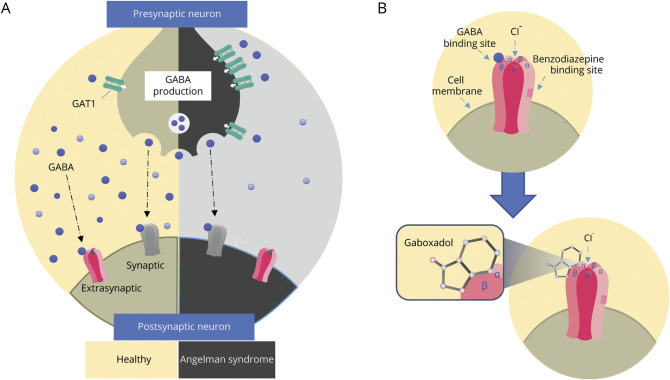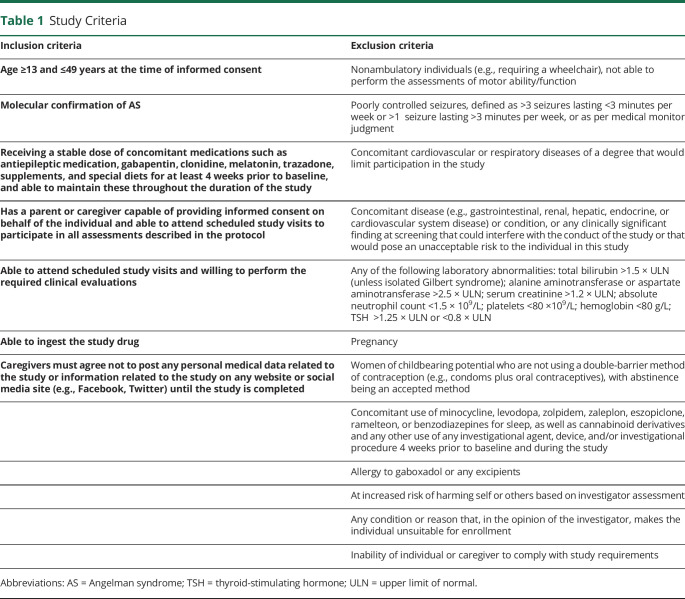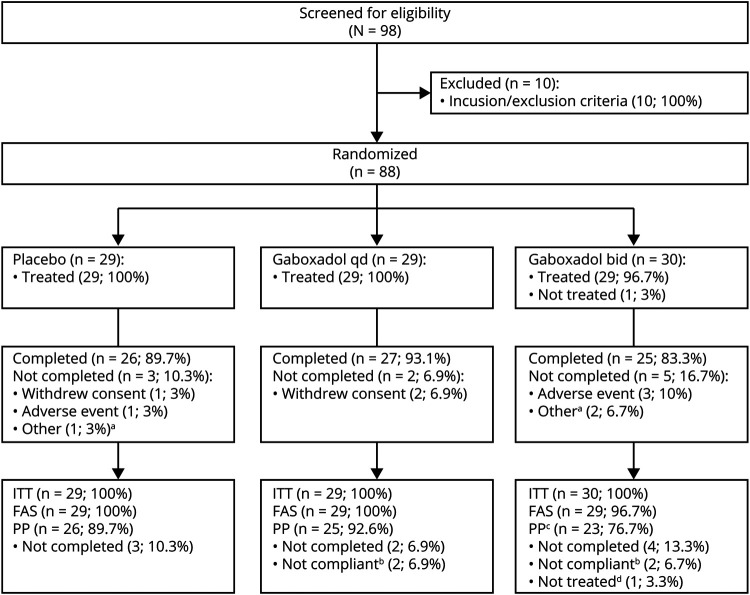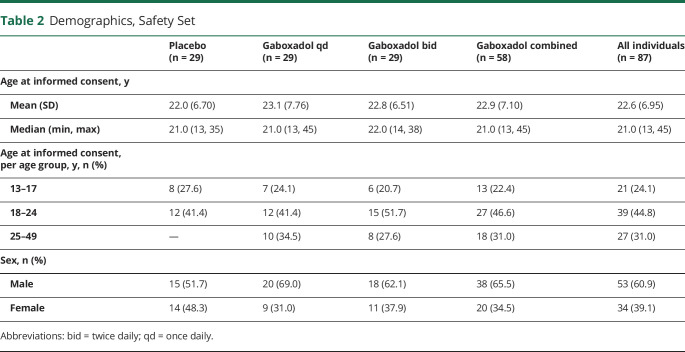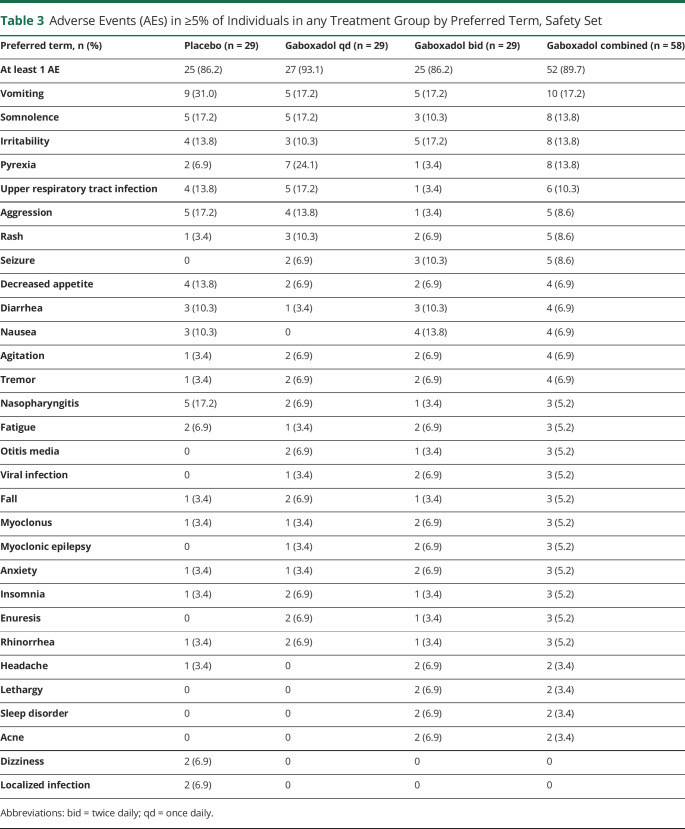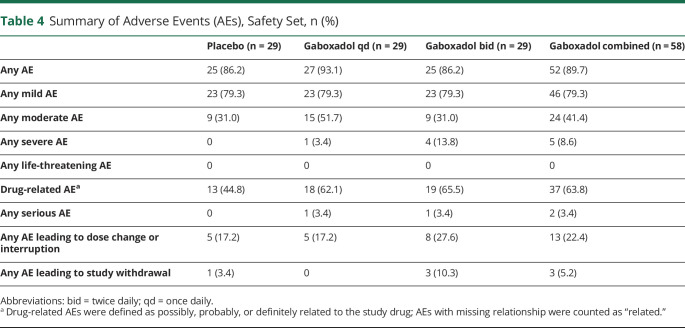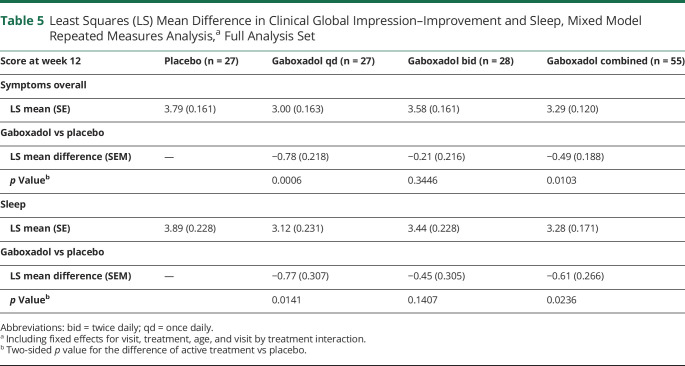Abstract
Objective
To evaluate safety and tolerability and exploratory efficacy end points for gaboxadol (OV101) compared with placebo in individuals with Angelman syndrome (AS).
Methods
Gaboxadol is a highly selective orthosteric agonist that activates δ-subunit–containing extrasynaptic γ-aminobutyric acid type A (GABAA) receptors. In a multicenter, double-blind, placebo-controlled, parallel-group trial, adolescent and adult individuals with a molecular diagnosis of AS were randomized (1:1:1) to 1 of 3 dosing regimens for a duration of 12 weeks: placebo morning dose and gaboxadol 15 mg evening dose (qd), gaboxadol 10 mg morning dose and 15 mg evening dose (bid), or placebo morning and evening dose. Safety and tolerability were monitored throughout the study. Prespecified exploratory efficacy end points included adapted Clinical Global Impression–Severity and Clinical Global Impression–Improvement (CGI-I) scales, which documented the clinical severity at baseline and change after treatment, respectively.
Results
Eighty-eight individuals were randomized. Of 87 individuals (aged 13–45 years) who received at least 1 dose of study drug, 78 (90%) completed the study. Most adverse events (AEs) were mild to moderate, and no life-threatening AEs were reported. Efficacy of gaboxadol, as measured by CGI-I improvement in an exploratory analysis, was observed in gaboxadol qd vs placebo (p = 0.0006).
Conclusion
After 12 weeks of treatment, gaboxadol was found to be generally well-tolerated with a favorable safety profile. The efficacy as measured by the AS-adapted CGI-I scale warrants further studies.
Clinicaltrials.gov Identifier
Classification of Evidence
This study provides Class I evidence that, for individuals with AS, gaboxadol is generally safe and well-tolerated.
First described in 1965, Angelman syndrome (AS) is a rare genetic neurodevelopmental condition with an estimated prevalence of 1/12,000 to 1/20,000.1 Commonly diagnosed before 5 years of age, AS is characterized by severe impairments in behavior, motor function, communication, and sleep, as well as intellectual disability, seizures, and ataxia.2,3 The molecular basis of AS was identified in 1987,4 and the unique ICD-10 code Q93.51 was introduced in 2018. Because of lack of therapies that target the underlying pathophysiology, individuals with AS have unmet clinical needs and burden.5
AS is caused primarily by loss of function of the maternally inherited ubiquitin protein ligase E3A gene (UBE3A).6,7 The disrupted UBE3A expression causes an increase in synaptic levels of γ-aminobutyric acid (GABA) transporter type 1 (GAT1) and, subsequently, an increased reuptake of GABA (figure 1A).7–10 The reduced extrasynaptic GABA levels lead to reduced activation of extrasynaptic GABAA receptors and attenuation of tonic inhibition. Loss of tonic inhibition plays a critical role in balancing neuronal excitability, which appears to contribute to the underlying pathophysiology of AS.11
Figure 1. γ-Aminobutyric Acid (GABA) Signaling in Physiologic Condition vs Angelman Syndrome.
(A, B) Loss of UBE3A causes reduced degradation of GABA transporter type 1 (GAT1) and upregulated GABA uptake.5–8 Cl– = chloride ion.
Gaboxadol (OV101) is a highly selective orthosteric agonist that activates δ-subunit–containing extrasynaptic GABAA receptors (figure 1B).11–14 When administered to mice with disrupted UBE3A expression, at dose levels expected to activate only extrasynaptic GABAA receptors, gaboxadol has restored deficits in tonic inhibition and ameliorated some of the neurologic symptoms seen in the AS mice.11
Methods
Standard Protocol Approvals, Registrations, and Patient Consents
The study (A Phase 2 Adult and Adolescent Angelman Syndrome Clinical Trial: A Randomized, Double-Blind, Safety and Efficacy Study of Gaboxadol; ClinicalTrials.gov identifier: NCT02996305) was reviewed and approved by institutional review boards/independent ethics committees at each site. Written informed consent was obtained from the legally authorized representative of each participating individual prior to any study procedures.
Study Design
The STARS phase 2 study was an international, multicenter, randomized, double-blind, placebo-controlled, parallel-group, safety and tolerability, 12-week trial of gaboxadol in individuals with AS, conducted at 12 sites in the United States and 1 in Israel, between January 24, 2017, and June 4, 2018 (supplemental table 1, doi:10.5061/dryad.k98sf7m4f).
Objectives
The objectives of this study were to evaluate safety and tolerability of 2 different gaboxadol dosing regimens in adult and adolescent individuals with AS receiving 12 weeks of treatment as assessed by frequency and severity of adverse events (AEs) vs placebo. Exploratory end points included assessments of behavior, motor function, and sleep, as well as evaluation of quality of life.
Participants
Adolescent and adult individuals (≥13 and ≤49 years) with a diagnosis of AS confirmed by molecular testing, on stable diets and receiving stable doses of concomitant medications for at least 4 weeks prior to the baseline visit, were eligible to participate. Individuals were excluded if they were nonambulatory, had poorly controlled seizures, had concomitant cardiovascular, hepatic, or respiratory diseases, or had significant laboratory abnormalities. Concomitant use of minocycline, levodopa, zolpidem, zaleplon, eszopiclone, ramelteon, benzodiazepines for sleep, cannabinoid derivatives, and any other investigational agent, device, or procedure 4 weeks prior to baseline and during the study were prohibited (table 1).
Table 1.
Study Criteria
Randomization, Treatment, and Titration
The participants were randomly assigned to 1 of 3 treatment groups (1:1:1): gaboxadol once daily (qd), gaboxadol twice daily (bid), or placebo bid. Randomization was made centrally via the Interactive Web Response System. Investigators, study staff, central readers, and caregivers/individuals were blinded to the randomized treatment assignments. Gaboxadol 5 mg and placebo were supplied in identical capsules provided in a kit including 2 bottles, each labeled for morning or evening administration.
The gaboxadol qd group received placebo in the morning and 15 mg gaboxadol in the evening. The gaboxadol bid group received gaboxadol 10 mg in the morning and 15 mg in the evening. The placebo group received placebo in the morning and in the evening. The dose began at 5 mg and was titrated in 5-mg increments over 2 weeks; dose escalation occurred after assessment of tolerability by the caregiver and investigator. Individuals were treated for up to 12 weeks at the highest tolerated dose (supplemental table 2, doi:10.5061/dryad.k98sf7m4f).
Outcome Measures
The Clinical Global Impression–Severity (CGI-S) scale was used to document the clinical severity of each participant at the baseline visit. The CGI-S was adapted for AS by including 9 domains that were identified by caregivers and AS clinical experts to capture the clinical spectrum of AS: (1) irritability/agitation/crying, (2) lethargy/social withdrawal, (3) stereotypic behavior, (4) hyperactivity, (5) inappropriate laughter/hyperexcitability, (6) gross motor ability, (7) fine motor ability, (8) anxiety, and (9) sleep. Based on clinical examinations of the individual with AS, interview of the caregiver, and review of all available data, changes (overall and in the 9 prespecified clinical domains) were assessed after 12 weeks of treatment using the similarly adapted Clinical Global Impression–Improvement (CGI-I) scale with baseline reference to CGI-S. The CGI-S and CGI-I scales are well-validated, clinician-rated tools commonly used in CNS drug development trials to measure global changes and treatment effects that are clinically meaningful.15–17 The CGI scales may be optimal for assessing severity and change in rare and heterogeneous neurodevelopmental disorders for which no validated disease-specific symptom scales have been developed, such as AS.18–20 The CGI-I has been previously used to assess efficacy of treatment in AS.15 The steps to ensure reliability and validity of CGI ratings included (1) training and certifying study raters based upon consensus ratings of prototypical cases, (2) retraining during the course of the trial, and (3) using the same rater–participant pair throughout the trial (a protocol deviation would be noted if rule 3 was violated). Safety, behavior, and mobility assessments were administered at baseline, week 6, and week 12.
End Points
The safety and tolerability of gaboxadol were examined by AE reporting along with monitoring of chemistry and hematology laboratory values, vital signs, physical examination, EEG, and concomitant medication use.
Exploratory End Points
Prespecified exploratory efficacy end points were based on the adapted CGI-I overall and for the 9 clinical domains: (1) irritability/agitation/crying, (2) lethargy/social withdrawal, (3) stereotypic behavior, (4) hyperactivity, (5) inappropriate laughter/hyperexcitability, (6) gross motor ability, (7) fine motor ability, (8) anxiety, and (9) sleep, with responders defined as having a CGI-I score of 3 or less overall or in any of the 9 clinical domains with 3 = minimally improved, 2 = much improved, or 1 = very much improved. Additional exploratory end points were change in the Aberrant Behavior Checklist–Community (ABC-C), which was developed for the developmentally disabled population and has been used in the AS population previously; change in Anxiety, Depression, and Mood Scales (ADAMS) total score; Sleep Pattern e-Diary; and change in the modified Performance Oriented Mobility Assessment–Gait (mPOMA-G).
Exploratory efficacy end points for global functioning and quality of life were based on the Parent Global Impression (PGI), European Quality of Life Five Dimension Five Level (EQ-5D-5L), 36-Item Short-Form Health Survey (SF-36), and CGI-S. Exploratory end points for motor function were based on the Pediatric Evaluation of Disability Inventory–Computer Adaptive Test (PEDI-CAT; daily activities and mobility), Childhood Health Assessment Questionnaire (CHAQ), and Zeno Walkway, and Bayley Scale of Infant and Toddler Development, 3rd Edition, Motor scales (BSID-III). Exploratory end points for sleep were based on actigraphy data. Actigraphy watches were provided to the caregivers and worn by the participating individuals to collect day and evening sleep-related outcomes (supplemental table 3, doi:10.5061/dryad.k98sf7m4f).
Classification of Evidence
The primary research question was to examine the safety and tolerability of gaboxadol in individuals with AS. This study provides Class I evidence that, for individuals with AS, gaboxadol is generally safe and well-tolerated.
Statistical Analysis
Sample size calculations were based on the objective of estimating AE rates within each active treatment group. The minimal sample size of 25 individuals per group provided the required precision for incidence estimation of common AEs using 2-sided 95% confidence interval (CI). For example, a 2-sided 95% CI for a true incidence of 25% will estimate that incidence with 17% precision (half width of the 95% CI). The intention-to-treat population consisted of all individuals randomized to treatment. Safety analyses were performed on the safety set, defined as individuals who received at least 1 dose of study drug. Efficacy analyses were performed on the full analysis set, defined as those individuals who received at least 1 dose of study drug and had at least 1 efficacy evaluation after receiving study drug. The per protocol set is a subset of the full analysis set and included all individuals who completed the week 12 visit and had no major protocol deviations that were deemed to affect efficacy.
AEs were coded using the Medical Dictionary for Regulatory Activities (MedDRA v19.1). Incidences of AEs and their 95% CIs were determined for each treatment group and summarized by MedDRA system organ class and preferred term. The number and percentage of individuals experiencing serious AEs, treatment-related AEs, and AEs leading to treatment discontinuation were also summarized for each treatment group.
Descriptive statistics (not including 95% CI) were calculated for laboratory values and vital signs by treatment group. Concomitant medication use was summarized. Descriptive statistics for observed value and change from baseline at each visit (if applicable) were reported for efficacy variables at each time point (week 6 and week 12) for the combined gaboxadol group (qd and bid) and placebo group. For the inferential analyses of key efficacy end points, type I error was controlled at the 0.05 significance level with a multiple-comparisons adjustment procedure (gated sequential testing). The prespecified testing hierarchy consisted of the following end points, tested in the order shown: (1) responder variable based on CGI-I overall and 9 specified domains, (2) composite responder variable for behavior based on the ADAMS and ABC-C questionnaires, (3) frequency of night awakenings derived from the sleep diary, (4) duration of night awakenings derived from the sleep diary, and (5) responder variable based on gross motor function assessed by mPOMA-G.
If the comparison of the combined gaboxadol group vs placebo was statistically significant for a specific end point (significance level, p ≤ 0.05), the result was followed up by statistical testing for each gaboxadol dose group vs placebo for that end point. Testing of the specific dose groups was prespecified if the comparison of the combined gaboxadol group vs placebo for an end point was statistically significant, and this testing was not included in the hierarchical gated sequential testing procedure. If the treatment difference for an end point was statistically significant, the components of the end point were tested. p Values are presented for supporting CGI-I tests, but only comparisons compliant with the prespecified hierarchical gated sequential testing procedure are reported as statistically significant. All other end point analyses were exploratory, and p values are considered descriptive only.
The identified responder end points indicating improvement at week 12 were compared between the combined gaboxadol group and placebo using a Fisher exact test. If the week 12 end point was not available, the week 6 end point was used as a method of imputation. For continuous end points with both week 6 and week 12 measurements (CGI-S, ADAMS, ABC-C [total and irritability domain], actigraphy, sleep diary, and CHAQ), a mixed model repeated measures (MMRM) analysis was used, and the response variable was change from baseline, with baseline as a covariate and fixed effects for visit, treatment, age group (adolescent, 13–17 years; adult, 18–49 years), and visit by treatment interaction. For the CGI-I end points (overall and 9 clinical domains), separate models were created for each measure with postbaseline score (response variable), as there was no baseline value to include as a covariate. An unstructured within-individual covariance structure was assumed. From this model, an estimate of the treatment difference at week 12 was generated (least squares [LS] mean), when comparing placebo with the qd, bid, and combined gaboxadol groups, with corresponding 2-sided p values.
As post hoc analysis, an additional CGI-I responder analysis was conducted separately for the 2 dose groups using a more rigorous definition of highly meaningful response on CGI-I overall of either 1 (very much improved) or 2 (much improved). If the week 12 end point was not available, the week 6 end point was used as a method of imputation. For continuous end points collected only at baseline and week 12 (BSID-III, PEDI-CAT, Zeno Walkway), change from baseline was analyzed using analysis of covariance model, with fixed effects for treatment, age group, and the corresponding baseline as a covariate. Estimates of the treatment means and difference at week 12 were generated when comparing placebo with the combined dose group, and each dose of gaboxadol, with corresponding 2-sided p values.
In a post hoc analysis, the changes from baseline to week 12 in the PEDI-CAT daily activity and mobility summary scores were compared between the gaboxadol qd group and placebo using a 2-sided t test, with corresponding 95% CI and p value. Analyses of the PEDI-CAT mobility score were conducted with and without excluding outliers, defined as individuals whose mobility score changed from screening to baseline by ≥3 points. Post hoc analyses were performed for the BSID-III total gross motor, total fine motor, and overall motor (gross and fine) scores. A responder was defined as improvement by 3 points or more in the week 12 score vs baseline. For BSID-III analyses, the differences in proportions of responders in the qd, bid, and combined gaboxadol groups vs placebo were compared using Fisher exact test, with corresponding exact 95% CI for the differences. All statistical analyses were performed using SAS for Windows (v 9.4). Selected efficacy analyses of week 12 end points include missing value adjustments, if possible, that use the corresponding week 6 observations either implicitly or by simple imputation (for binary end points). For all other analyses, observed case data were used without imputations for missing data.
Data Availability
Ovid Therapeutics Inc. is committed to providing qualified scientific researchers appropriate access to anonymized data and clinical study information from the company's clinical trials for the purpose of conducting legitimate scientific research. Requests for specific data will be considered along with the rationale, description of use need, and clinical value of the proposed analysis. Ovid supports an approach to sharing data that responsibly reflects the interests of all parties involved in clinical trials, including protecting the rights and privacy of trial participants, the innovator's intellectual property rights, and other incentives for innovation, and as such, will evaluate requests for sharing company clinical trial data with qualified external scientific researchers. Requests to access the data from this clinical trial may be made at clinical@ovidrx.com. Data will be made available for request after product approval in the United States and European Union, after product development is discontinued, or as otherwise required by law or regulation. There are circumstances that may prevent Ovid from sharing the requested data as the product is investigational at this time.
Results
Study Population
The intention-to-treat population consisted of 88 individuals randomized to participate in the trial, including 1 who was randomized to gaboxadol bid but who did not receive treatment (figure 2 and tables 1 and 2). The full analysis set/safety set consisted of 87 individuals randomized into 3 groups: 29 who received gaboxadol qd, 29 who received gaboxadol bid, and 29 who received placebo. Seventy-eight (90%) individuals completed the study. Baseline ratings on the CGI-S scale were similar in all 3 groups, excluding a chance clustering of more severely affected individuals in any treatment group. Seizure history was balanced among the treatment groups; 93% had a history of seizure, including 37% who reported having had seizures within the past 2 years. Concomitant use of nonbenzodiazepine and benzodiazepine medications administered for seizures, and benzodiazepines used for other purposes “as needed,” were similar among all treatment groups (supplemental tables 4 and 5, doi:10.5061/dryad.k98sf7m4f).
Figure 2. CONSORT (Consolidated Standards of Reporting Trials) Diagram.
aIncludes individuals unwilling to participate, investigator decision due to medication change, and caregiver withdrawal. bDefined as compliance <60%. cExcluded individuals could have >1 reason; primary reason given. dWithdrew after randomization for inability to comply with study. bid = twice daily; FAS = full analysis set; ITT = intention-to-treat set; PP = per protocol set; qd = once daily.
Table 2.
Demographics, Safety Set
Safety
During the 12-week trial period, 2 serious AEs of seizure were reported, 1 in the gaboxadol qd (not related) and 1 in the gaboxadol bid group (possibly study drug related) (supplemental table 6, doi:10.5061/dryad.k98sf7m4f). Four individuals discontinued the study due to AEs, 1 treated with placebo (irritability) and 3 treated with gaboxadol bid (seizure, n = 1; myoclonus, n = 1; and irritability/anxiety/sleep disorder, n = 1; supplemental table 6, doi:10.5061/dryad.k98sf7m4f). A comparison between the treatment groups reveals a safety profile with similar proportion of AEs; the majority of AEs were mild to moderate, and no life-threatening AEs were reported (tables 3 and 4). Study drug–related AEs occurred at a greater incidence among individuals treated with gaboxadol qd (62%) than among those who received placebo (45%) (table 4). The AEs that occurred at least 5% more frequently (2 or more individuals in a treatment group; table 3) in the qd group vs placebo included pyrexia (24% and 7%, respectively), rash (10% and 3%, respectively), and seizure, otitis media, and enuresis (each 7% and 0, respectively). AEs that occurred at least 5% more frequently in the bid group vs placebo included unspecified seizures (10% and 0, respectively), and viral infection, myoclonic seizures, lethargy, sleep disorder, and acne (each 7% and 0, respectively). The percentage of individuals requiring a dose interruption or change due to an AE was higher with gaboxadol bid (28%) vs gaboxadol qd and placebo (each 17%) (supplemental tables 7–9, doi:10.5061/dryad.k98sf7m4f). The irritability domain of the ABC-C was used as a proxy for suicidal ideation, and no differences in change from baseline were found for gaboxadol qd or bid vs placebo. Results of hematology and chemistry testing in the combined groups showed no differences from placebo. There were no differences or discernible trends between treatment groups in vital signs or physical examination findings. The incidences of moderate and severe slowing and of occipital rhythm on EEG were similar at baseline and week 12, and similar among treatment groups.
Table 3.
Adverse Events (AEs) in ≥5% of Individuals in any Treatment Group by Preferred Term, Safety Set
Table 4.
Summary of Adverse Events (AEs), Safety Set, n (%)
Exploratory Efficacy End Points
Global Function
The prespecified responder analysis of the adapted CGI-I showed an improvement in the combined gaboxadol group at week 12 compared to placebo (66.7% and 39.3%, respectively; p = 0.0206). When this responder analysis was carried out post hoc for the 2 dose groups using a more rigorous definition of “highly meaningful” response on CGI-I of either 1 (very much improved) or 2 (much improved), the qd group showed an improvement at week 12 vs placebo (32.1% and 7.1%, respectively; descriptive p = 0.0403), but no improvement was observed in the gaboxadol bid group compared to placebo (10.3% and 7.1%; descriptive p = 1.0000). A prespecified supportive MMRM analysis of CGI-I overall showed an improvement in the qd group vs placebo (LS mean difference, −0.78; SE 0.218; p = 0.0006), whereas the bid group showed no difference from placebo (LS mean, −0.21; SE, 0.216; p = 0.3446) (table 5).
Table 5.
Least Squares (LS) Mean Difference in Clinical Global Impression–Improvement and Sleep, Mixed Model Repeated Measures Analysis,a Full Analysis Set
Behavior
An exploratory analysis of PGI domain responses showed a higher proportion of individuals in gaboxadol qd (n = 28) had CGI-I score ≤2 and PGI score of improved (a little, moderately, a lot) vs bid (n = 28) and placebo (n = 27) within the domains of behavior (3 [10.7%], 2 [7.1%], and 1 [3.7%], respectively), nonverbal communication (6 [21.4%], 2 [7.1%], and 1 [3.7%], respectively), verbal communication (3 [10.7%], 1 [3.6%], and 0 [0%], respectively), and anxiety (4 [14.3%], 2 [7.1%], and 1 [3.7%], respectively).
Motor Function
Exploratory post hoc analyses conducted on the BSID-III gross and fine motor domains did not reveal any statistically significant differences vs placebo. For the gross motor domain, the gaboxadol qd group showed a change vs placebo (difference, 24.5%; 95% CI, 0.1, 48.4; and descriptive p = 0.052), whereas the bid group showed no difference from placebo (descriptive p = 0.070). There were no differences between the groups for the fine motor domain of BSID-III. On the CHAQ Disability Index (a prespecified exploratory end point) at week 12 no difference was seen for the 2 dosing groups vs placebo.
The Zeno Walkway data showed a reduction from baseline in the gaboxadol qd group vs placebo in mean stride velocity (n = 24, LS mean, 0.56, SEM, 3.273; and n = 24, LS mean, 9.68, SEM, 3.271; 95% CI, −17.84, −0.40, and descriptive p = 0.0406) and cadence (n = 24, LS mean, −0.47, SEM, 2.149; and n = 24, LS mean, 5.79, SEM 2.162; 95% CI, −12.05, −0.49 and descriptive p = 0.0340). The bid group showed similar findings for cadence and no difference from placebo in mean stride velocity. Post hoc analyses of change from baseline to week 12 in PEDI-CAT daily activity scores (mean, 0.69; SE, 0.434; 95% CI, −0.18, 1.56) and PEDI-CAT mobility scores (excluding outliers defined as a difference in total score between screening and baseline ≥3; mean, 0.68; SE, 0.397; 95% CI, −0.12, 1.48), showed no difference in the qd group vs placebo.
Sleep
The CGI-I sleep domain score improved in the gaboxadol qd group vs placebo (MMRM: LS mean, −0.77; SEM, 0.307; p = 0.0141), whereas the bid group showed no difference from placebo (LS mean, −0.45; SEM, 0.305; p = 0.1407) (table 5). Because of technical issues with the devices or noncompliance, actigraphy data were missing for approximately 50% of the participants. Descriptive analysis of the evaluable actigraphy data showed changes in sleep-onset latency from baseline to week 12 in the qd (LS mean, −11.0; SE, 8.49), placebo (LS mean, 14.7; SE, 6.56), and bid (LS mean, 2.6; SE, 7.24) groups with a treatment difference for the qd group of −25.7 minutes (95% CI, −46.08, −5.29; p = 0.0147).
Over the course of the 12-week study, sleep-onset latency shortened in the qd group, remained relatively unaffected in the bid group (with a transient reduction observed at 1 week following initiation of treatment), and lengthened in the placebo group (supplemental table 10, doi:10.5061/dryad.k98sf7m4f). Improvements were suggested in “total sleep time during the day” and “sleep efficiency” in the qd group vs placebo, and decreased “total sleep time at night” in the bid arm (supplemental table 10, doi:10.5061/dryad.k98sf7m4f). Of the 9 CGI-I domains, only sleep showed an improvement. A post hoc evaluation of the relationship between the CGI-I sleep domain and the other CGI-I domains at week 12 found no significant correlations in the qd group (correlation coefficient [CC], range, −0.16 [anxiety] to 0.38 [symptoms overall]), whereas in the bid group, the CGI-I sleep domain correlated with several domains to a moderate to strong degree, including inappropriate laughter or hyperexcitability (CC, 0.52), gross motor ability (CC, 0.62), fine motor ability (CC, 0.56), and symptoms overall (CC, 0.84) (supplemental table 11, doi:10.5061/dryad.k98sf7m4f).
Exploratory Efficacy: Other Scales
No change was found between the combined gaboxadol group vs placebo for the end points in the hierarchical testing procedure for the ADAMS, ABC-C, mPOMA-G, and Sleep Pattern e-Diary. No change was found in a comparison of the combined gaboxadol group vs placebo for the end points in the Seizure Activity e-Diary, EQ-5D-5L questionnaire, SF-36 Health Survey, or PGI scale. Change from baseline to week 12 in CGI-S was found to be minimal for all 3 study groups.
Discussion
Many symptoms of AS are heterogenous and vary throughout the patient's lifespan. Preclinical studies in a mouse model with an inactivated maternal Ube3a gene (Ube3am-/p) showed loss of tonic inhibition in cerebellar granule cells,11 as well as motor dysfunction.21 GABA, the main inhibitory neurotransmitter in the mammalian brain, signals through 2 major receptor types comprising multiple subtypes,22 while GABAergic inhibitory signaling within the CNS proceeds through activation of pentameric GABAA receptors.23–25 Decreased activation of extrasynaptic GABAA receptors affects the postsynaptic membrane potential and overall neuronal excitability through a phasic inhibitory chloride ion (Cl–) current in the postsynaptic neuron.11,22–24,26–28 Through the highly selective activation of extrasynaptic GABAA receptors, gaboxadol has the potential to restore the deficit in tonic inhibition,25 which animal model evidence suggests may play a central role in the underlying neuropathophysiology of AS.11
The STARS phase 2 study found that gaboxadol was generally well-tolerated with an overall favorable safety profile, as demonstrated by primarily mild to moderate AEs and few treatment discontinuations owing to AEs (table 4; supplemental table 9, doi:10.5061/dryad.k98sf7m4f). It should be noted that 1 individual discontinued gaboxadol bid treatment owing to myoclonus, which can be difficult to treat. While the study was not designed to be sufficiently powered for efficacy outcomes, the CGI-I nevertheless showed a gaboxadol treatment effect. It is notable that the CGI-I response for gaboxadol qd showed a clear separation from placebo, while gaboxadol bid did not. The CGI-I was used as a global assessment to allow clinicians to capture improvement overall and in a constellation of clinical symptoms—including communication, behavior, gross and fine motor ability, and sleep—relevant for individuals with AS and their caregivers. Exploration of the drivers for the CGI-I findings showed modest improvements for gaboxadol qd only in sleep. While more sensitive outcome measures may be required to accurately capture other end points, these findings provide insights into the observed improvements in CGI-I.
An important finding from this study was that gaboxadol qd was associated with improved CGI-I scores, whereas gaboxadol bid was not. Notably, sustained improvement in sleep-onset latency, as measured by the actigraphy watch, was observed with the qd dose, an effect not observed with bid dosing. To examine the hypothesis that sleep may be the underlying cause of the observed improvements in CGI-I, a post hoc analysis found that the CGI-I sleep symptom score for gaboxadol qd was unrelated to other domain scores, suggesting the effect on sleep may be independent from other clinical changes.
A theoretical explanation for the lack of improvement in CGI-I in the bid group at 6 and 12 weeks, along with the lack of sustained effect on sleep-onset latency, could be that participants receiving the higher bid dosing may have developed tolerance to gaboxadol.29 Development of tolerance is consistent with previous preclinical and clinical findings involving GABAergic drugs (benzodiazepines,30 neurosteroids,31,32 barbiturates,32 certain anesthetics,33 and chronic alcohol administration33), including those that act at the extrasynaptic GABAA receptor. Functional desensitization to gaboxadol in mice has been observed with time and dose level.11,34 It should be appreciated that GABAergic signaling through GABAA receptors, including those extrasynaptic variants containing a δ-subunit, is a highly dynamic process under the influence of a host of controls that may lead to desensitization and development of tolerance to treatment, causing reduced therapeutic effect at higher doses. Other potential explanations for a lack of dose response may include a false-positive result due to chance and small sample size.
In designing and conducting this trial, several obstacles common to trials in rare neurologic disorders were encountered. Although the seizure history among the participants was balanced and consistent with previous studies,34,35 AS is a heterogeneous condition with respect to both genotype and phenotype. This heterogeneity, coupled with the lack of validated tools to measure symptoms in AS, presents numerous challenges for trial design and clinical end point selection. The concerns regarding heterogeneity might have been mitigated by implementing stricter exclusion criteria, but the criteria were designed to represent a more inclusive AS population.
There were several limitations of this study. Because of the inherent nature of their disabilities, individuals with AS are unable to report their symptoms independently, and a caregiver is required to infer symptoms from observed behaviors, which introduces an element of subjectivity into the reporting. Individuals and caregivers experienced difficulties in completing the sleep pattern e-Diary and using the actigraphy watch, partly due to technical limitations and the participants' sensitivity to wearing the devices; this poor compliance meant data were available for only half of the study participants. The variable degrees of gait disturbances present in most individuals with AS made it challenging to interpret the walkway data. Another limitation of the study is that the BSID-III is not designed to capture change in response to treatment in a 12-week study, but instead to identify areas of developmental delays. For this reason, implementation of the clinician assessment such as the CGI-S and CGI-I provided an additional source of tracking treatment response.
Originally designed for use in neuropsychiatric disorders, typically the CGI scales are paired with 1 or more disease-specific rating scales that establish the basis of the global ratings. Because there are no condition-specific rating scales for AS, the study team established 9 domains to be evaluated (based on literature reviews, caregiver interviews, and AS experts' clinical guidance) to permit exploration of which domains might be most affected by gaboxadol. Raters were clinicians experienced in working with children with disabilities and, although we attempted to minimize interrater differences through training and consistency of rater–participant pairs, interrater reliability statistics were not captured. Intrarater reliability remains an area for additional exploration.
This study demonstrates that gaboxadol was generally safe and well-tolerated in individuals with AS. Evidence for clinical global improvement, as measured by the CGI-I, was found in the gaboxadol qd group, with potential contributions from the domains of behavior, motor function, communication, and sleep. These results support further clinical development of gaboxadol for AS.
Acknowledgment
The authors thank the individuals and their families for participating in this study and the health care personnel and administrative staff at each medical center for their continuous support. Assistance for statistical analyses was provided by Shijie Chen, Ovid Therapeutics Inc., New York, NY, and additional contributions to the manuscript were provided by Judith Jaeger, CognitionMetrics, LLC. Editorial support and medical writing assistance were provided by Daniel Famer, PhD, Ovid Therapeutics Inc., New York, NY. Additional editorial support was provided by Ashfield Healthcare Communications and funded by Ovid Therapeutics Inc.
Glossary
- ABC-C
Aberrant Behavior Checklist–Community
- ADAMS
Anxiety, Depression, and Mood Scales
- AE
adverse event
- AS
Angelman syndrome
- BSID-III
Bayley Scale of Infant and Toddler Development, 3rd Edition, Motor scales
- CC
correlation coefficient
- CGI-I
Clinical Global Impression–Improvement
- CGI-S
Clinical Global Impression–Severity
- CHAQ
Childhood Health Assessment Questionnaire
- CI
confidence interval
- EQ-5D-5L
European Quality of Life Five Dimension Five Level
- GABA
γ-aminobutyric acid
- ICD-10
International Classification of Diseases–10
- LS
least squares
- MedDRA
Medical Dictionary for Regulatory Activities
- MMRM
mixed model repeated measures
- mPOMA-G
modified Performance Oriented Mobility Assessment–Gait
- PEDI-CAT
Pediatric Evaluation of Disability Inventory–Computer Adaptive Test
- PGI
Parent Global Impression
- SF-36
36-Item Short-Form Health Survey
Appendix. Authors

Footnotes
Class of Evidence: NPub.org/coe
Study Funding
Funded by Ovid Therapeutics Inc.
Disclosure
L.M. Bird has received research support from Ovid Therapeutics Inc. and consulted for Ionis Pharmaceuticals and F. Hoffman LaRoche. C. Ochoa-Lubinoff and R.D. Burdine have consulted for Ovid. A. Kolevzon has received research support from AMO Pharma and consulted for Ovid, Acadia, and sema4. W.-H. Tan has received indirect funding for statistical analyses from Ovid. J. Visootsak was an employee of Ovid at the time of the clinical trial and during the development of the first draft of the manuscript. A. Kolevzon, R.D. Burdine, and R.L. Thibert were members of the STARS trial steering committee. Go to Neurology.org/Nhttps://n.neurology.org/lookup/doi/10.1212/WNL.0000000000011409 for full disclosures.
References
- 1.Williams CH, Peters SU, Calculator S. Facts about Angelman Syndrome, 7th ed. Angelman Syndrome Foundation; 2009. [Google Scholar]
- 2.Buiting K, Williams C, Horsthemke B. Angelman syndrome: insights into a rare neurogenetic disorder. Nat Rev Neurol 2016;12:584–593. [DOI] [PubMed] [Google Scholar]
- 3.Williams CA, Beaudet AL, Clayton-Smith J, et al. Angelman syndrome 2005: updated consensus for diagnostic criteria. Am J Med Genet A 2006;140:413–418. [DOI] [PubMed] [Google Scholar]
- 4.Magenis RE, Brown MG, Lacy DA, Budden S, LaFranchi S. Is Angelman syndrome an alternate result of del(15)(q11q13)? Am J Med Genet 1987;28:829–838. [DOI] [PubMed] [Google Scholar]
- 5.Wheeler AC, Sacco P, Cabo R. Unmet clinical needs and burden in Angelman syndrome: a review of the literature. Orphanet J Rare Dis 2017;12:164. [DOI] [PMC free article] [PubMed] [Google Scholar]
- 6.Dagli AI, Mueller J, Williams CA. Angelman Syndrome. GeneReviews®. Posted September 15, 1998. Revised December 21, 2017. Available at: ncbi.nlm.nih.gov/books/NBK1144/. Accessed March 10, 2020. [Google Scholar]
- 7.Chamberlain SJ, Lalande M. Angelman syndrome, a genomic imprinting disorder of the brain. J Neurosci 2010;30:9958–9963. [DOI] [PMC free article] [PubMed] [Google Scholar]
- 8.Brickley SG, Mody I. Extrasynaptic GABA(A) receptors: their function in the CNS and implications for disease. Neuron 2012;73:23–34. [DOI] [PMC free article] [PubMed] [Google Scholar]
- 9.Deidda G, Bozarth IF, Cancedda L. Modulation of GABAergic transmission in development and neurodevelopmental disorders: investigating physiology and pathology to gain therapeutic perspectives. Front Cell Neurosci 2014;8:119. [DOI] [PMC free article] [PubMed] [Google Scholar]
- 10.Egawa K, Fukuda A. Pathophysiological power of improper tonic GABA(A) conductances in mature and immature models. Front Neural Circuits 2013;7:170. [DOI] [PMC free article] [PubMed] [Google Scholar]
- 11.Egawa K, Kitagawa K, Inoue K, et al. Decreased tonic inhibition in cerebellar granule cells causes motor dysfunction in a mouse model of Angelman syndrome. Sci Transl Med 2012;4:163ra157. [DOI] [PubMed] [Google Scholar]
- 12.Meera P, Wallner M, Otis TS. Molecular basis for the high THIP/gaboxadol sensitivity of extrasynaptic GABA(A) receptors. J Neurophysiol 2011;106:2057–2064. [DOI] [PMC free article] [PubMed] [Google Scholar]
- 13.Belelli D, Peden DR, Rosahl TW, Wafford KA, Lambert JJ. Extrasynaptic GABAA receptors of thalamocortical neurons: a molecular target for hypnotics. J Neurosci 2005;25:11513–11520. [DOI] [PMC free article] [PubMed] [Google Scholar]
- 14.Brown N, Kerby J, Bonnert TP, Whiting PJ, Wafford KA. Pharmacological characterization of a novel cell line expressing human alpha(4)beta(3)delta GABA(A) receptors. Br J Pharmacol 2002;136:965–974. [DOI] [PMC free article] [PubMed] [Google Scholar]
- 15.Ruiz-Antoran B, Sancho-Lopez A, Cazorla-Calleja R, et al. A randomized placebo controlled clinical trial to evaluate the efficacy and safety of minocycline in patients with Angelman syndrome (A-MANECE study). Orphanet J Rare Dis 2018;13:144. [DOI] [PMC free article] [PubMed] [Google Scholar]
- 16.Berry-Kravis E, Hagerman R, Visootsak J, et al. Arbaclofen in fragile X syndrome: results of phase 3 trials. J Neurodev Disord 2017;9:3. [DOI] [PMC free article] [PubMed] [Google Scholar]
- 17.McCracken JT, McGough J, Shah B, et al. Risperidone in children with autism and serious behavioral problems. N Engl J Med 2002;347:314–321. [DOI] [PubMed] [Google Scholar]
- 18.Bailey DB, Jr., Berry-Kravis E, Wheeler A, et al. Mavoglurant in adolescents with fragile X syndrome: analysis of Clinical Global Impression–Improvement source data from a double-blind therapeutic study followed by an open-label, long-term extension study. J Neurodev Disord 2016;8:1. [DOI] [PMC free article] [PubMed] [Google Scholar]
- 19.Grieco JC, Ciarlone SL, Gieron-Korthals M, et al. An open-label pilot trial of minocycline in children as a treatment for Angelman syndrome. BMC Neurol 2014;14:232. [DOI] [PMC free article] [PubMed] [Google Scholar]
- 20.Leigh MJ, Nguyen DV, Mu Y, et al. A randomized double-blind, placebo-controlled trial of minocycline in children and adolescents with fragile X syndrome. J Dev Behav Pediatr 2013;34:147–155. [DOI] [PMC free article] [PubMed] [Google Scholar]
- 21.Jiang YH, Armstrong D, Albrecht U, et al. Mutation of the Angelman ubiquitin ligase in mice causes increased cytoplasmic p53 and deficits of contextual learning and long-term potentiation. Neuron 1998;21:799–811. [DOI] [PubMed] [Google Scholar]
- 22.McCarson KE, Enna SJ. GABA pharmacology: the search for analgesics. Neurochem Res 2014;39:1948–1963. [DOI] [PubMed] [Google Scholar]
- 23.Olsen RW, Tobin AJ. Molecular biology of GABAA receptors. FASEB J 1990;4:1469–1480. [DOI] [PubMed] [Google Scholar]
- 24.Nutt DJ, Malizia AL. New insights into the role of the GABA(A)-benzodiazepine receptor in psychiatric disorder. Br J Psychiatry 2001;179:390–396. [DOI] [PubMed] [Google Scholar]
- 25.Olsen RW, Sieghart W. GABA A receptors: subtypes provide diversity of function and pharmacology. Neuropharmacology 2009;56:141–148. [DOI] [PMC free article] [PubMed] [Google Scholar]
- 26.Bruinsma CF, Schonewille M, Gao Z, et al. Dissociation of locomotor and cerebellar deficits in a murine Angelman syndrome model. J Clin Invest 2015;125:4305–4315. [DOI] [PMC free article] [PubMed] [Google Scholar]
- 27.Jia F, Pignataro L, Schofield CM, Yue M, Harrison NL, Goldstein PA. An extrasynaptic GABAA receptor mediates tonic inhibition in thalamic VB neurons. J Neurophysiol 2005;94:4491–4501. [DOI] [PubMed] [Google Scholar]
- 28.Brickley SG, Cull-Candy SG, Farrant M. Development of a tonic form of synaptic inhibition in rat cerebellar granule cells resulting from persistent activation of GABAA receptors. J Physiol 1996;497:753–759. [DOI] [PMC free article] [PubMed] [Google Scholar]
- 29.Brodie MJ. Established anticonvulsants and treatment of refractory epilepsy. Lancet 1990;336:350–354. [DOI] [PubMed] [Google Scholar]
- 30.Vinkers CH, Olivier B. Mechanisms underlying tolerance after long-term benzodiazepine use: a future for subtype-selective GABA(A) receptor modulators? Adv Pharmacol Sci 2012;2012:416864. [DOI] [PMC free article] [PubMed] [Google Scholar]
- 31.Turkmen S, Backstrom T, Wahlstrom G, Andreen L, Johansson IM. Tolerance to allopregnanolone with focus on the GABA-A receptor. Br J Pharmacol 2011;162:311–327. [DOI] [PMC free article] [PubMed] [Google Scholar]
- 32.Barnes EM Jr. Use-dependent regulation of GABAA receptors. Int Rev Neurobiol 1996;39:53–76. [DOI] [PubMed] [Google Scholar]
- 33.Liang J, Spigelman I, Olsen RW. Tolerance to sedative/hypnotic actions of GABAergic drugs correlates with tolerance to potentiation of extrasynaptic tonic currents of alcohol-dependent rats. J Neurophysiol 2009;102:224–233. [DOI] [PMC free article] [PubMed] [Google Scholar]
- 34.Larson AM, Shinnick JE, Shaaya EA, Thiele EA, Thibert RL. Angelman syndrome in adulthood. Am J Med Genet A 2015;167A:331–344. [DOI] [PMC free article] [PubMed] [Google Scholar]
- 35.Prasad A, Grocott O, Parkin K, Larson A, Thibert RL. Angelman syndrome in adolescence and adulthood: a retrospective chart review of 53 cases. Am J Med Genet A 2018;176:1327–1334. [DOI] [PubMed] [Google Scholar]
Associated Data
This section collects any data citations, data availability statements, or supplementary materials included in this article.
Data Availability Statement
Ovid Therapeutics Inc. is committed to providing qualified scientific researchers appropriate access to anonymized data and clinical study information from the company's clinical trials for the purpose of conducting legitimate scientific research. Requests for specific data will be considered along with the rationale, description of use need, and clinical value of the proposed analysis. Ovid supports an approach to sharing data that responsibly reflects the interests of all parties involved in clinical trials, including protecting the rights and privacy of trial participants, the innovator's intellectual property rights, and other incentives for innovation, and as such, will evaluate requests for sharing company clinical trial data with qualified external scientific researchers. Requests to access the data from this clinical trial may be made at clinical@ovidrx.com. Data will be made available for request after product approval in the United States and European Union, after product development is discontinued, or as otherwise required by law or regulation. There are circumstances that may prevent Ovid from sharing the requested data as the product is investigational at this time.



